Comparative Analysis: Cross Cultural Management in Australia and UK
VerifiedAdded on 2019/11/14
|19
|5003
|177
Report
AI Summary
This report provides a comparative analysis of cross-cultural management practices, focusing on firms in Australia and the United Kingdom. The study evaluates management processes and organizational culture, considering factors like individualism versus group orientation, communication styles, decision-making approaches, and leadership styles. The report utilizes Hofstede's cultural dimensions to highlight similarities and differences, emphasizing the impact of cultural variations on managerial effectiveness. It examines how cultural nuances influence communication, decision-making, team management, and superior-subordinate relationships. The report offers real-world examples, such as the practices of McKinsey & Company, to illustrate the challenges and opportunities faced by international managers in navigating diverse cultural contexts. The conclusion underscores the importance of understanding and adapting to cultural differences to ensure effective management and organizational success in a globalized business environment.
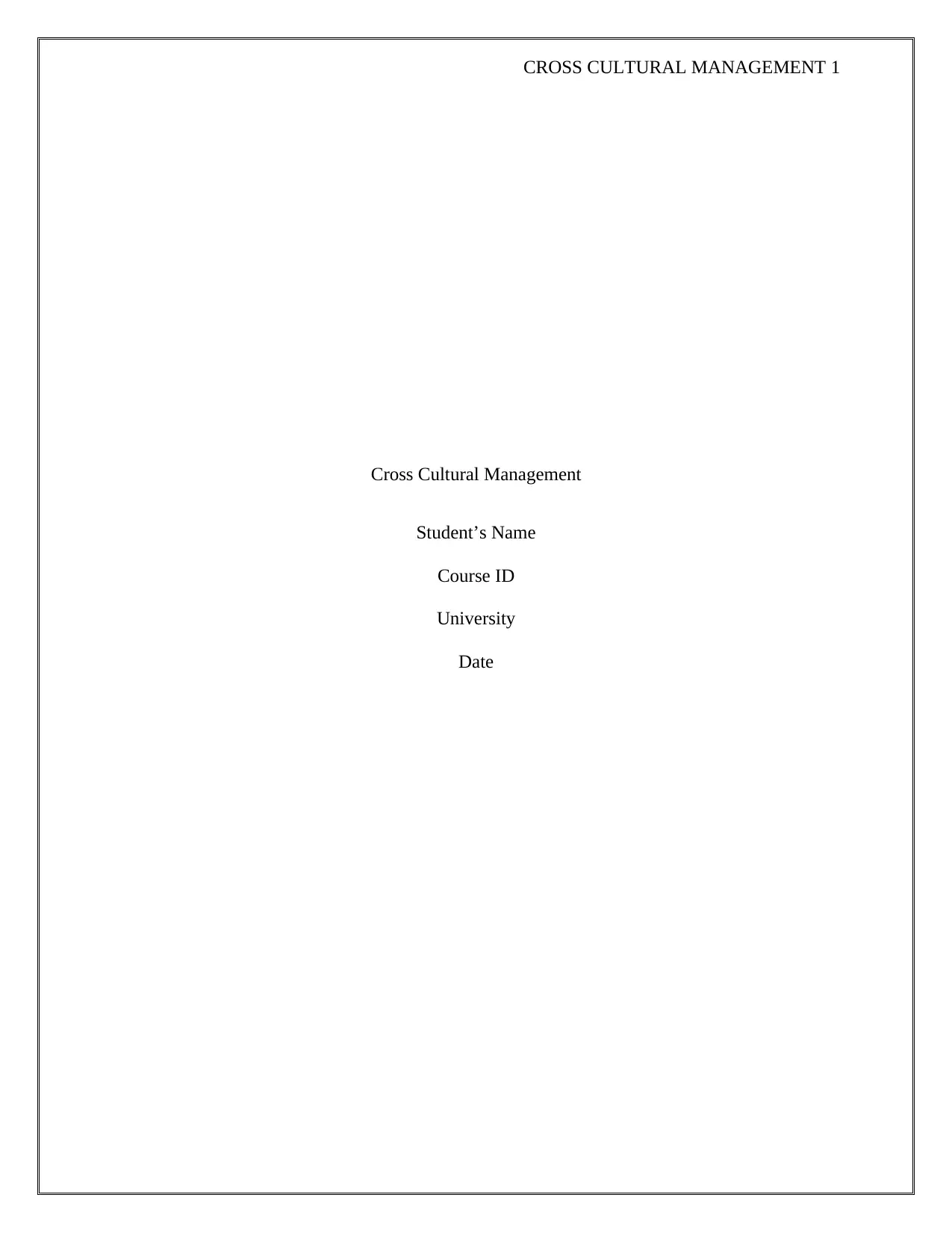
CROSS CULTURAL MANAGEMENT 1
Cross Cultural Management
Student’s Name
Course ID
University
Date
Cross Cultural Management
Student’s Name
Course ID
University
Date
Paraphrase This Document
Need a fresh take? Get an instant paraphrase of this document with our AI Paraphraser
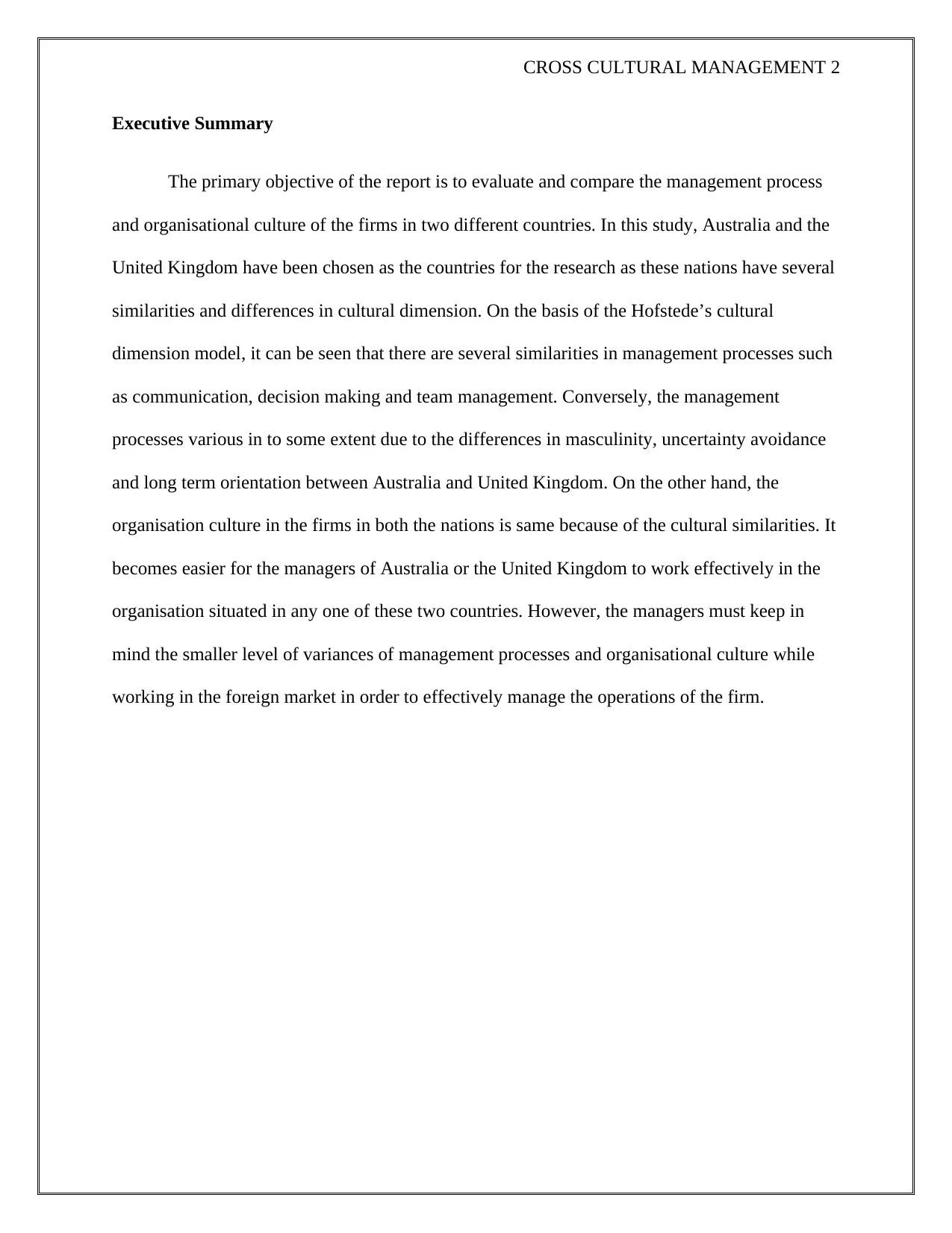
CROSS CULTURAL MANAGEMENT 2
Executive Summary
The primary objective of the report is to evaluate and compare the management process
and organisational culture of the firms in two different countries. In this study, Australia and the
United Kingdom have been chosen as the countries for the research as these nations have several
similarities and differences in cultural dimension. On the basis of the Hofstede’s cultural
dimension model, it can be seen that there are several similarities in management processes such
as communication, decision making and team management. Conversely, the management
processes various in to some extent due to the differences in masculinity, uncertainty avoidance
and long term orientation between Australia and United Kingdom. On the other hand, the
organisation culture in the firms in both the nations is same because of the cultural similarities. It
becomes easier for the managers of Australia or the United Kingdom to work effectively in the
organisation situated in any one of these two countries. However, the managers must keep in
mind the smaller level of variances of management processes and organisational culture while
working in the foreign market in order to effectively manage the operations of the firm.
Executive Summary
The primary objective of the report is to evaluate and compare the management process
and organisational culture of the firms in two different countries. In this study, Australia and the
United Kingdom have been chosen as the countries for the research as these nations have several
similarities and differences in cultural dimension. On the basis of the Hofstede’s cultural
dimension model, it can be seen that there are several similarities in management processes such
as communication, decision making and team management. Conversely, the management
processes various in to some extent due to the differences in masculinity, uncertainty avoidance
and long term orientation between Australia and United Kingdom. On the other hand, the
organisation culture in the firms in both the nations is same because of the cultural similarities. It
becomes easier for the managers of Australia or the United Kingdom to work effectively in the
organisation situated in any one of these two countries. However, the managers must keep in
mind the smaller level of variances of management processes and organisational culture while
working in the foreign market in order to effectively manage the operations of the firm.
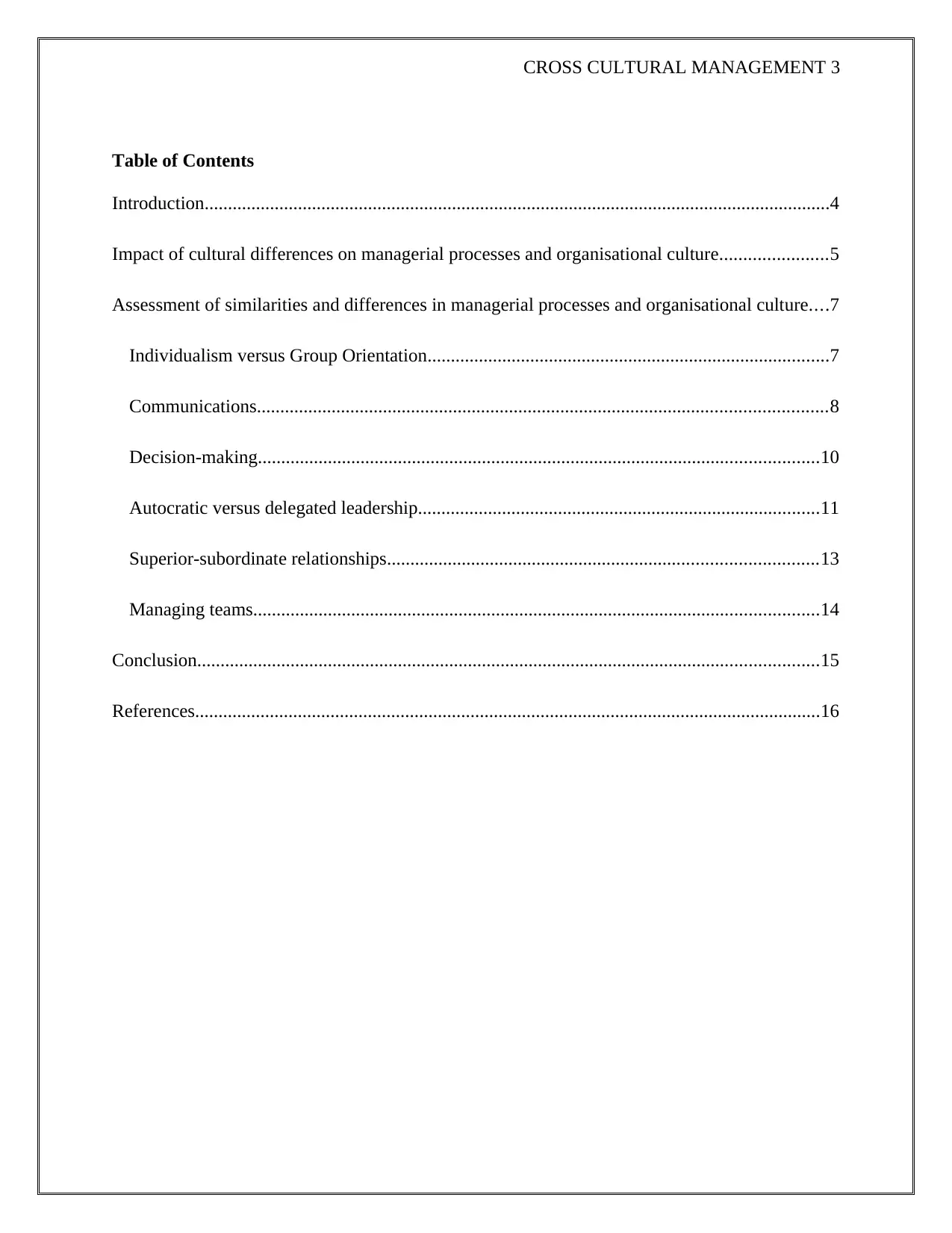
CROSS CULTURAL MANAGEMENT 3
Table of Contents
Introduction......................................................................................................................................4
Impact of cultural differences on managerial processes and organisational culture.......................5
Assessment of similarities and differences in managerial processes and organisational culture....7
Individualism versus Group Orientation......................................................................................7
Communications..........................................................................................................................8
Decision-making........................................................................................................................10
Autocratic versus delegated leadership......................................................................................11
Superior-subordinate relationships............................................................................................13
Managing teams.........................................................................................................................14
Conclusion.....................................................................................................................................15
References......................................................................................................................................16
Table of Contents
Introduction......................................................................................................................................4
Impact of cultural differences on managerial processes and organisational culture.......................5
Assessment of similarities and differences in managerial processes and organisational culture....7
Individualism versus Group Orientation......................................................................................7
Communications..........................................................................................................................8
Decision-making........................................................................................................................10
Autocratic versus delegated leadership......................................................................................11
Superior-subordinate relationships............................................................................................13
Managing teams.........................................................................................................................14
Conclusion.....................................................................................................................................15
References......................................................................................................................................16
⊘ This is a preview!⊘
Do you want full access?
Subscribe today to unlock all pages.

Trusted by 1+ million students worldwide
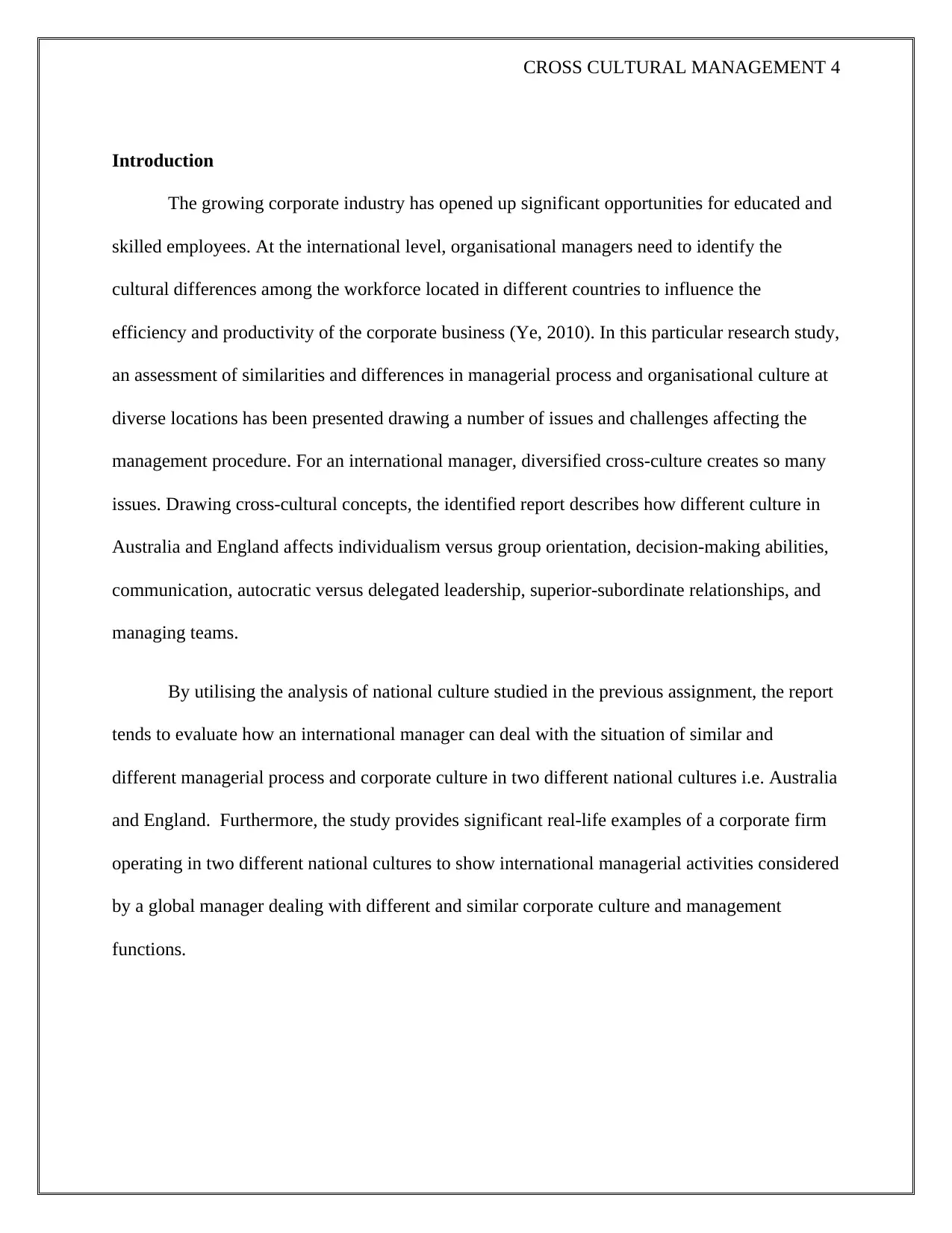
CROSS CULTURAL MANAGEMENT 4
Introduction
The growing corporate industry has opened up significant opportunities for educated and
skilled employees. At the international level, organisational managers need to identify the
cultural differences among the workforce located in different countries to influence the
efficiency and productivity of the corporate business (Ye, 2010). In this particular research study,
an assessment of similarities and differences in managerial process and organisational culture at
diverse locations has been presented drawing a number of issues and challenges affecting the
management procedure. For an international manager, diversified cross-culture creates so many
issues. Drawing cross-cultural concepts, the identified report describes how different culture in
Australia and England affects individualism versus group orientation, decision-making abilities,
communication, autocratic versus delegated leadership, superior-subordinate relationships, and
managing teams.
By utilising the analysis of national culture studied in the previous assignment, the report
tends to evaluate how an international manager can deal with the situation of similar and
different managerial process and corporate culture in two different national cultures i.e. Australia
and England. Furthermore, the study provides significant real-life examples of a corporate firm
operating in two different national cultures to show international managerial activities considered
by a global manager dealing with different and similar corporate culture and management
functions.
Introduction
The growing corporate industry has opened up significant opportunities for educated and
skilled employees. At the international level, organisational managers need to identify the
cultural differences among the workforce located in different countries to influence the
efficiency and productivity of the corporate business (Ye, 2010). In this particular research study,
an assessment of similarities and differences in managerial process and organisational culture at
diverse locations has been presented drawing a number of issues and challenges affecting the
management procedure. For an international manager, diversified cross-culture creates so many
issues. Drawing cross-cultural concepts, the identified report describes how different culture in
Australia and England affects individualism versus group orientation, decision-making abilities,
communication, autocratic versus delegated leadership, superior-subordinate relationships, and
managing teams.
By utilising the analysis of national culture studied in the previous assignment, the report
tends to evaluate how an international manager can deal with the situation of similar and
different managerial process and corporate culture in two different national cultures i.e. Australia
and England. Furthermore, the study provides significant real-life examples of a corporate firm
operating in two different national cultures to show international managerial activities considered
by a global manager dealing with different and similar corporate culture and management
functions.
Paraphrase This Document
Need a fresh take? Get an instant paraphrase of this document with our AI Paraphraser
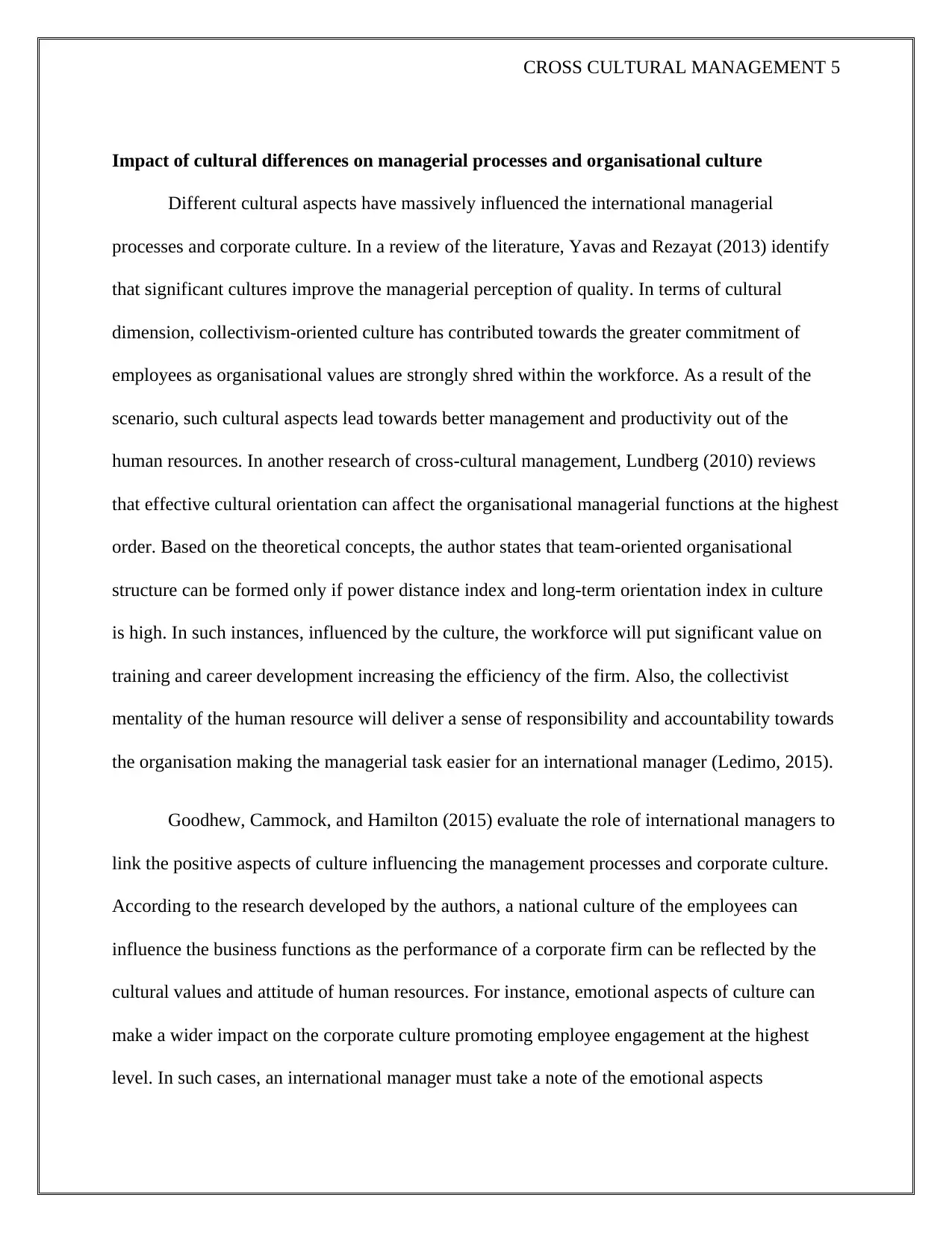
CROSS CULTURAL MANAGEMENT 5
Impact of cultural differences on managerial processes and organisational culture
Different cultural aspects have massively influenced the international managerial
processes and corporate culture. In a review of the literature, Yavas and Rezayat (2013) identify
that significant cultures improve the managerial perception of quality. In terms of cultural
dimension, collectivism-oriented culture has contributed towards the greater commitment of
employees as organisational values are strongly shred within the workforce. As a result of the
scenario, such cultural aspects lead towards better management and productivity out of the
human resources. In another research of cross-cultural management, Lundberg (2010) reviews
that effective cultural orientation can affect the organisational managerial functions at the highest
order. Based on the theoretical concepts, the author states that team-oriented organisational
structure can be formed only if power distance index and long-term orientation index in culture
is high. In such instances, influenced by the culture, the workforce will put significant value on
training and career development increasing the efficiency of the firm. Also, the collectivist
mentality of the human resource will deliver a sense of responsibility and accountability towards
the organisation making the managerial task easier for an international manager (Ledimo, 2015).
Goodhew, Cammock, and Hamilton (2015) evaluate the role of international managers to
link the positive aspects of culture influencing the management processes and corporate culture.
According to the research developed by the authors, a national culture of the employees can
influence the business functions as the performance of a corporate firm can be reflected by the
cultural values and attitude of human resources. For instance, emotional aspects of culture can
make a wider impact on the corporate culture promoting employee engagement at the highest
level. In such cases, an international manager must take a note of the emotional aspects
Impact of cultural differences on managerial processes and organisational culture
Different cultural aspects have massively influenced the international managerial
processes and corporate culture. In a review of the literature, Yavas and Rezayat (2013) identify
that significant cultures improve the managerial perception of quality. In terms of cultural
dimension, collectivism-oriented culture has contributed towards the greater commitment of
employees as organisational values are strongly shred within the workforce. As a result of the
scenario, such cultural aspects lead towards better management and productivity out of the
human resources. In another research of cross-cultural management, Lundberg (2010) reviews
that effective cultural orientation can affect the organisational managerial functions at the highest
order. Based on the theoretical concepts, the author states that team-oriented organisational
structure can be formed only if power distance index and long-term orientation index in culture
is high. In such instances, influenced by the culture, the workforce will put significant value on
training and career development increasing the efficiency of the firm. Also, the collectivist
mentality of the human resource will deliver a sense of responsibility and accountability towards
the organisation making the managerial task easier for an international manager (Ledimo, 2015).
Goodhew, Cammock, and Hamilton (2015) evaluate the role of international managers to
link the positive aspects of culture influencing the management processes and corporate culture.
According to the research developed by the authors, a national culture of the employees can
influence the business functions as the performance of a corporate firm can be reflected by the
cultural values and attitude of human resources. For instance, emotional aspects of culture can
make a wider impact on the corporate culture promoting employee engagement at the highest
level. In such cases, an international manager must take a note of the emotional aspects
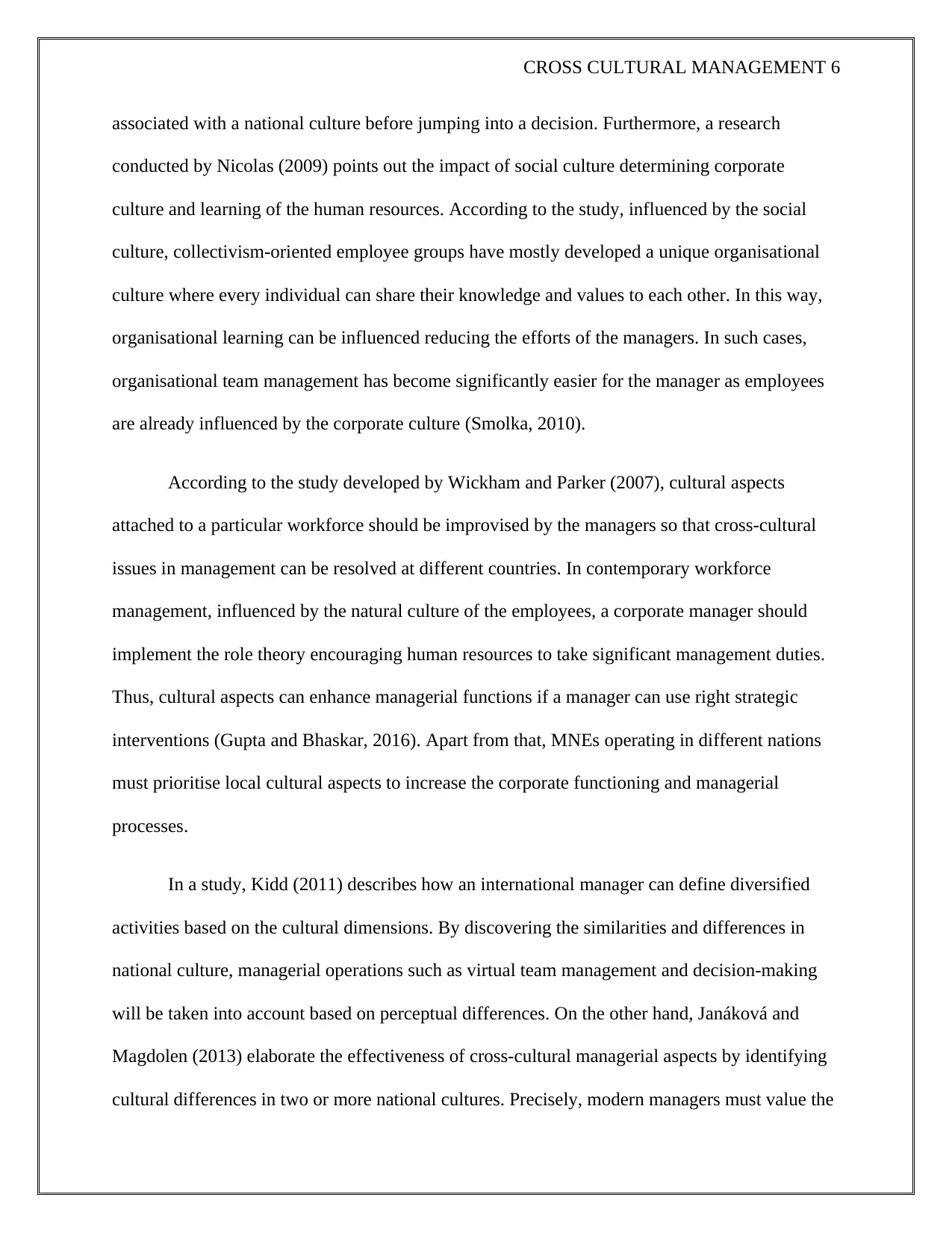
CROSS CULTURAL MANAGEMENT 6
associated with a national culture before jumping into a decision. Furthermore, a research
conducted by Nicolas (2009) points out the impact of social culture determining corporate
culture and learning of the human resources. According to the study, influenced by the social
culture, collectivism-oriented employee groups have mostly developed a unique organisational
culture where every individual can share their knowledge and values to each other. In this way,
organisational learning can be influenced reducing the efforts of the managers. In such cases,
organisational team management has become significantly easier for the manager as employees
are already influenced by the corporate culture (Smolka, 2010).
According to the study developed by Wickham and Parker (2007), cultural aspects
attached to a particular workforce should be improvised by the managers so that cross-cultural
issues in management can be resolved at different countries. In contemporary workforce
management, influenced by the natural culture of the employees, a corporate manager should
implement the role theory encouraging human resources to take significant management duties.
Thus, cultural aspects can enhance managerial functions if a manager can use right strategic
interventions (Gupta and Bhaskar, 2016). Apart from that, MNEs operating in different nations
must prioritise local cultural aspects to increase the corporate functioning and managerial
processes.
In a study, Kidd (2011) describes how an international manager can define diversified
activities based on the cultural dimensions. By discovering the similarities and differences in
national culture, managerial operations such as virtual team management and decision-making
will be taken into account based on perceptual differences. On the other hand, Janáková and
Magdolen (2013) elaborate the effectiveness of cross-cultural managerial aspects by identifying
cultural differences in two or more national cultures. Precisely, modern managers must value the
associated with a national culture before jumping into a decision. Furthermore, a research
conducted by Nicolas (2009) points out the impact of social culture determining corporate
culture and learning of the human resources. According to the study, influenced by the social
culture, collectivism-oriented employee groups have mostly developed a unique organisational
culture where every individual can share their knowledge and values to each other. In this way,
organisational learning can be influenced reducing the efforts of the managers. In such cases,
organisational team management has become significantly easier for the manager as employees
are already influenced by the corporate culture (Smolka, 2010).
According to the study developed by Wickham and Parker (2007), cultural aspects
attached to a particular workforce should be improvised by the managers so that cross-cultural
issues in management can be resolved at different countries. In contemporary workforce
management, influenced by the natural culture of the employees, a corporate manager should
implement the role theory encouraging human resources to take significant management duties.
Thus, cultural aspects can enhance managerial functions if a manager can use right strategic
interventions (Gupta and Bhaskar, 2016). Apart from that, MNEs operating in different nations
must prioritise local cultural aspects to increase the corporate functioning and managerial
processes.
In a study, Kidd (2011) describes how an international manager can define diversified
activities based on the cultural dimensions. By discovering the similarities and differences in
national culture, managerial operations such as virtual team management and decision-making
will be taken into account based on perceptual differences. On the other hand, Janáková and
Magdolen (2013) elaborate the effectiveness of cross-cultural managerial aspects by identifying
cultural differences in two or more national cultures. Precisely, modern managers must value the
⊘ This is a preview!⊘
Do you want full access?
Subscribe today to unlock all pages.

Trusted by 1+ million students worldwide
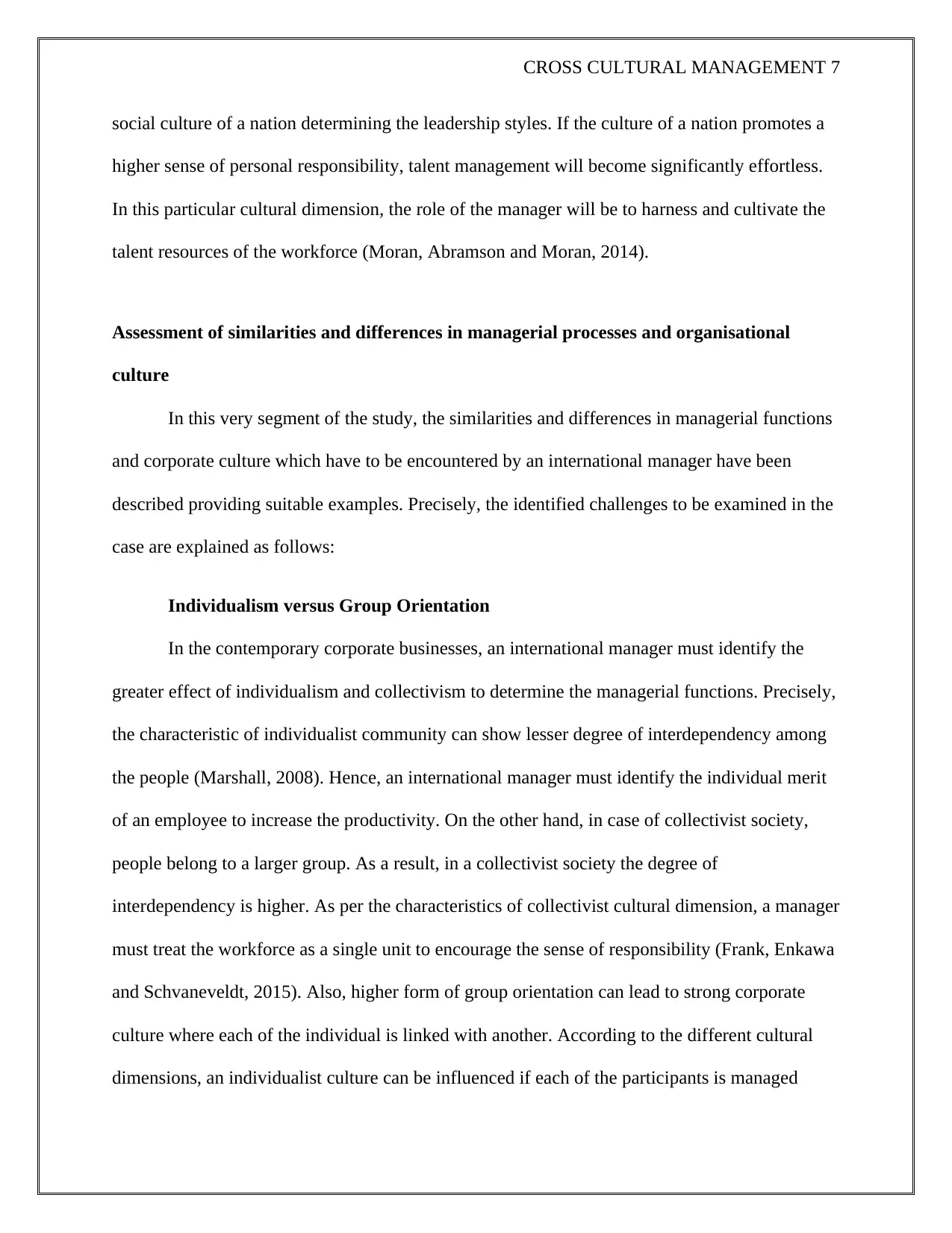
CROSS CULTURAL MANAGEMENT 7
social culture of a nation determining the leadership styles. If the culture of a nation promotes a
higher sense of personal responsibility, talent management will become significantly effortless.
In this particular cultural dimension, the role of the manager will be to harness and cultivate the
talent resources of the workforce (Moran, Abramson and Moran, 2014).
Assessment of similarities and differences in managerial processes and organisational
culture
In this very segment of the study, the similarities and differences in managerial functions
and corporate culture which have to be encountered by an international manager have been
described providing suitable examples. Precisely, the identified challenges to be examined in the
case are explained as follows:
Individualism versus Group Orientation
In the contemporary corporate businesses, an international manager must identify the
greater effect of individualism and collectivism to determine the managerial functions. Precisely,
the characteristic of individualist community can show lesser degree of interdependency among
the people (Marshall, 2008). Hence, an international manager must identify the individual merit
of an employee to increase the productivity. On the other hand, in case of collectivist society,
people belong to a larger group. As a result, in a collectivist society the degree of
interdependency is higher. As per the characteristics of collectivist cultural dimension, a manager
must treat the workforce as a single unit to encourage the sense of responsibility (Frank, Enkawa
and Schvaneveldt, 2015). Also, higher form of group orientation can lead to strong corporate
culture where each of the individual is linked with another. According to the different cultural
dimensions, an individualist culture can be influenced if each of the participants is managed
social culture of a nation determining the leadership styles. If the culture of a nation promotes a
higher sense of personal responsibility, talent management will become significantly effortless.
In this particular cultural dimension, the role of the manager will be to harness and cultivate the
talent resources of the workforce (Moran, Abramson and Moran, 2014).
Assessment of similarities and differences in managerial processes and organisational
culture
In this very segment of the study, the similarities and differences in managerial functions
and corporate culture which have to be encountered by an international manager have been
described providing suitable examples. Precisely, the identified challenges to be examined in the
case are explained as follows:
Individualism versus Group Orientation
In the contemporary corporate businesses, an international manager must identify the
greater effect of individualism and collectivism to determine the managerial functions. Precisely,
the characteristic of individualist community can show lesser degree of interdependency among
the people (Marshall, 2008). Hence, an international manager must identify the individual merit
of an employee to increase the productivity. On the other hand, in case of collectivist society,
people belong to a larger group. As a result, in a collectivist society the degree of
interdependency is higher. As per the characteristics of collectivist cultural dimension, a manager
must treat the workforce as a single unit to encourage the sense of responsibility (Frank, Enkawa
and Schvaneveldt, 2015). Also, higher form of group orientation can lead to strong corporate
culture where each of the individual is linked with another. According to the different cultural
dimensions, an individualist culture can be influenced if each of the participants is managed
Paraphrase This Document
Need a fresh take? Get an instant paraphrase of this document with our AI Paraphraser
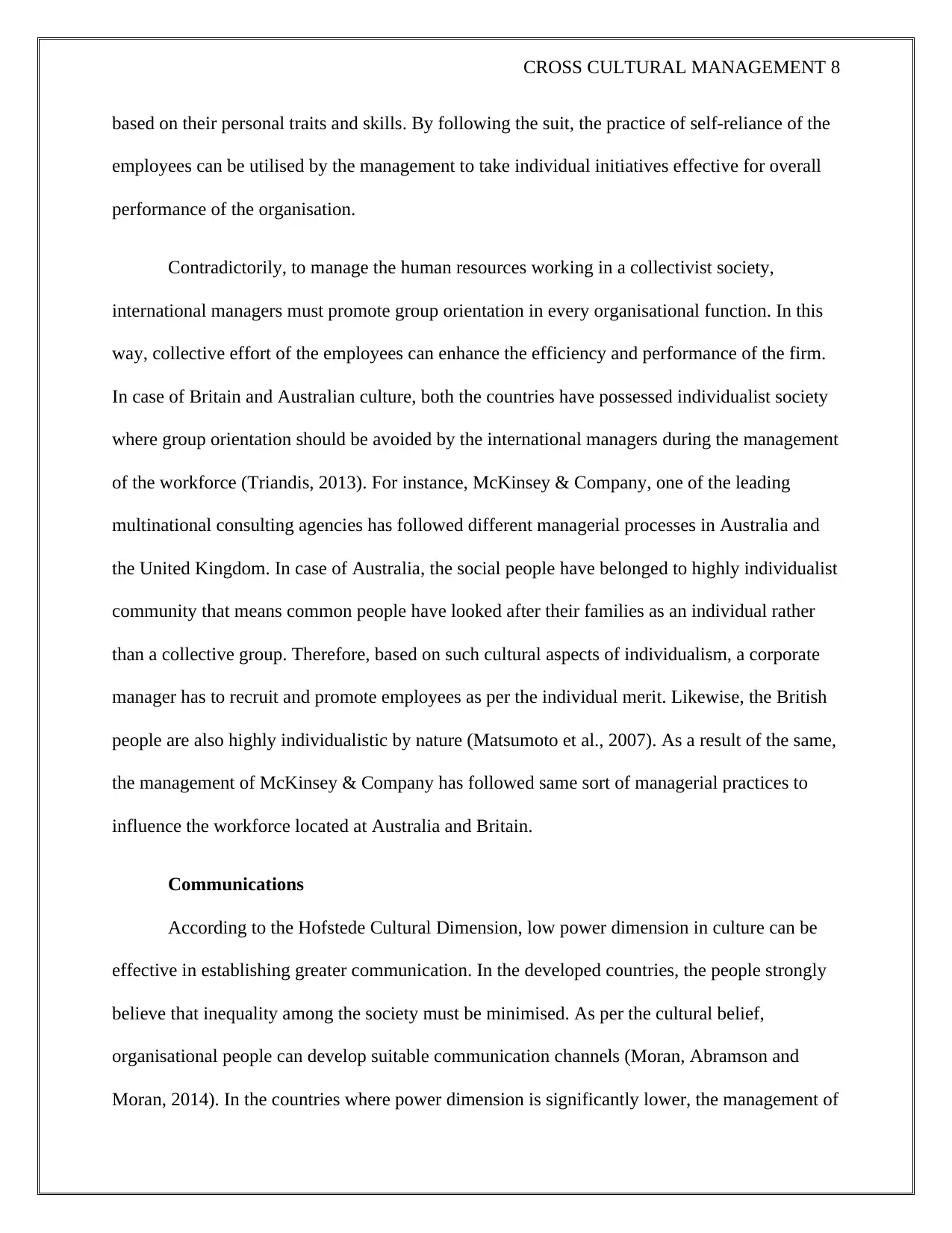
CROSS CULTURAL MANAGEMENT 8
based on their personal traits and skills. By following the suit, the practice of self-reliance of the
employees can be utilised by the management to take individual initiatives effective for overall
performance of the organisation.
Contradictorily, to manage the human resources working in a collectivist society,
international managers must promote group orientation in every organisational function. In this
way, collective effort of the employees can enhance the efficiency and performance of the firm.
In case of Britain and Australian culture, both the countries have possessed individualist society
where group orientation should be avoided by the international managers during the management
of the workforce (Triandis, 2013). For instance, McKinsey & Company, one of the leading
multinational consulting agencies has followed different managerial processes in Australia and
the United Kingdom. In case of Australia, the social people have belonged to highly individualist
community that means common people have looked after their families as an individual rather
than a collective group. Therefore, based on such cultural aspects of individualism, a corporate
manager has to recruit and promote employees as per the individual merit. Likewise, the British
people are also highly individualistic by nature (Matsumoto et al., 2007). As a result of the same,
the management of McKinsey & Company has followed same sort of managerial practices to
influence the workforce located at Australia and Britain.
Communications
According to the Hofstede Cultural Dimension, low power dimension in culture can be
effective in establishing greater communication. In the developed countries, the people strongly
believe that inequality among the society must be minimised. As per the cultural belief,
organisational people can develop suitable communication channels (Moran, Abramson and
Moran, 2014). In the countries where power dimension is significantly lower, the management of
based on their personal traits and skills. By following the suit, the practice of self-reliance of the
employees can be utilised by the management to take individual initiatives effective for overall
performance of the organisation.
Contradictorily, to manage the human resources working in a collectivist society,
international managers must promote group orientation in every organisational function. In this
way, collective effort of the employees can enhance the efficiency and performance of the firm.
In case of Britain and Australian culture, both the countries have possessed individualist society
where group orientation should be avoided by the international managers during the management
of the workforce (Triandis, 2013). For instance, McKinsey & Company, one of the leading
multinational consulting agencies has followed different managerial processes in Australia and
the United Kingdom. In case of Australia, the social people have belonged to highly individualist
community that means common people have looked after their families as an individual rather
than a collective group. Therefore, based on such cultural aspects of individualism, a corporate
manager has to recruit and promote employees as per the individual merit. Likewise, the British
people are also highly individualistic by nature (Matsumoto et al., 2007). As a result of the same,
the management of McKinsey & Company has followed same sort of managerial practices to
influence the workforce located at Australia and Britain.
Communications
According to the Hofstede Cultural Dimension, low power dimension in culture can be
effective in establishing greater communication. In the developed countries, the people strongly
believe that inequality among the society must be minimised. As per the cultural belief,
organisational people can develop suitable communication channels (Moran, Abramson and
Moran, 2014). In the countries where power dimension is significantly lower, the management of
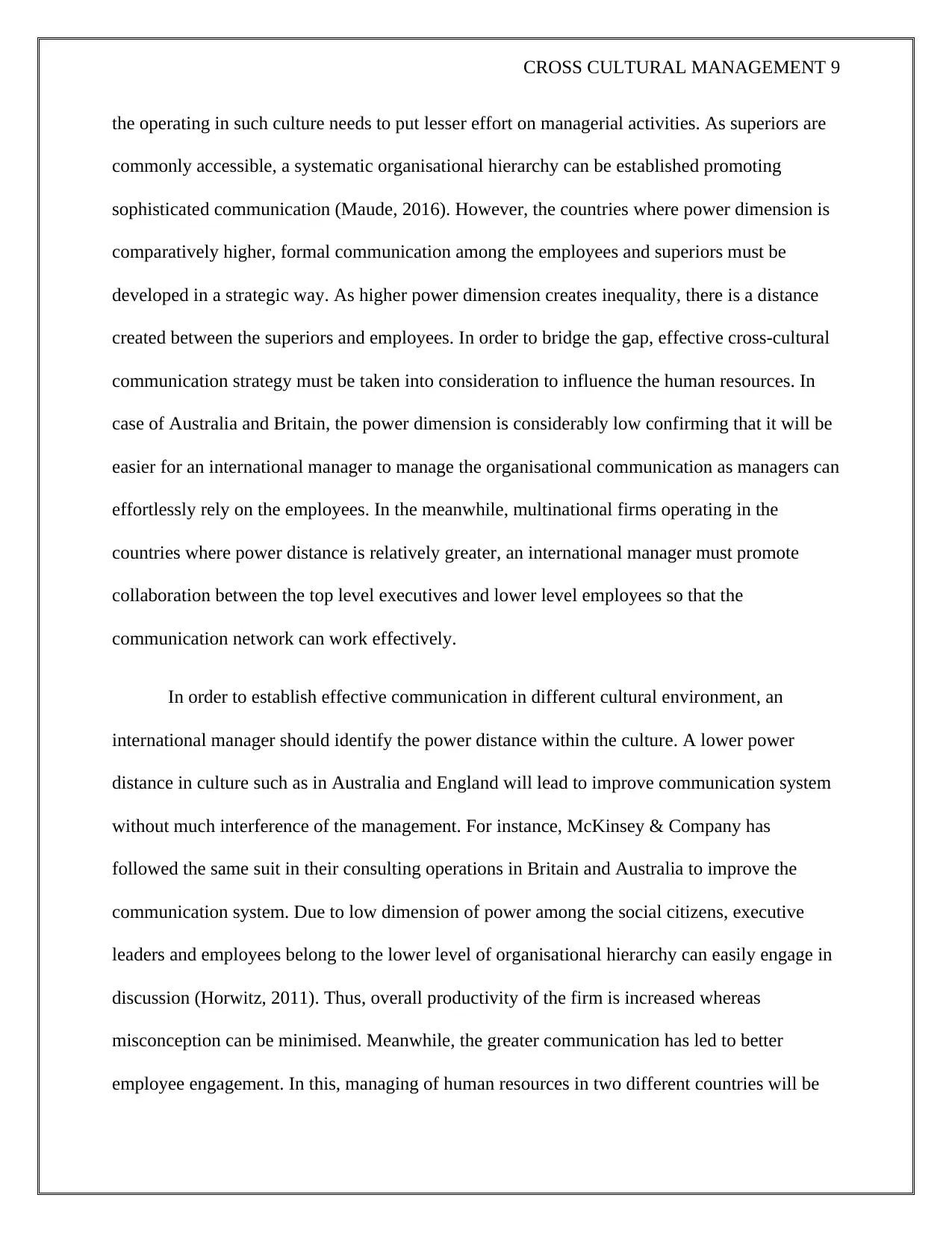
CROSS CULTURAL MANAGEMENT 9
the operating in such culture needs to put lesser effort on managerial activities. As superiors are
commonly accessible, a systematic organisational hierarchy can be established promoting
sophisticated communication (Maude, 2016). However, the countries where power dimension is
comparatively higher, formal communication among the employees and superiors must be
developed in a strategic way. As higher power dimension creates inequality, there is a distance
created between the superiors and employees. In order to bridge the gap, effective cross-cultural
communication strategy must be taken into consideration to influence the human resources. In
case of Australia and Britain, the power dimension is considerably low confirming that it will be
easier for an international manager to manage the organisational communication as managers can
effortlessly rely on the employees. In the meanwhile, multinational firms operating in the
countries where power distance is relatively greater, an international manager must promote
collaboration between the top level executives and lower level employees so that the
communication network can work effectively.
In order to establish effective communication in different cultural environment, an
international manager should identify the power distance within the culture. A lower power
distance in culture such as in Australia and England will lead to improve communication system
without much interference of the management. For instance, McKinsey & Company has
followed the same suit in their consulting operations in Britain and Australia to improve the
communication system. Due to low dimension of power among the social citizens, executive
leaders and employees belong to the lower level of organisational hierarchy can easily engage in
discussion (Horwitz, 2011). Thus, overall productivity of the firm is increased whereas
misconception can be minimised. Meanwhile, the greater communication has led to better
employee engagement. In this, managing of human resources in two different countries will be
the operating in such culture needs to put lesser effort on managerial activities. As superiors are
commonly accessible, a systematic organisational hierarchy can be established promoting
sophisticated communication (Maude, 2016). However, the countries where power dimension is
comparatively higher, formal communication among the employees and superiors must be
developed in a strategic way. As higher power dimension creates inequality, there is a distance
created between the superiors and employees. In order to bridge the gap, effective cross-cultural
communication strategy must be taken into consideration to influence the human resources. In
case of Australia and Britain, the power dimension is considerably low confirming that it will be
easier for an international manager to manage the organisational communication as managers can
effortlessly rely on the employees. In the meanwhile, multinational firms operating in the
countries where power distance is relatively greater, an international manager must promote
collaboration between the top level executives and lower level employees so that the
communication network can work effectively.
In order to establish effective communication in different cultural environment, an
international manager should identify the power distance within the culture. A lower power
distance in culture such as in Australia and England will lead to improve communication system
without much interference of the management. For instance, McKinsey & Company has
followed the same suit in their consulting operations in Britain and Australia to improve the
communication system. Due to low dimension of power among the social citizens, executive
leaders and employees belong to the lower level of organisational hierarchy can easily engage in
discussion (Horwitz, 2011). Thus, overall productivity of the firm is increased whereas
misconception can be minimised. Meanwhile, the greater communication has led to better
employee engagement. In this, managing of human resources in two different countries will be
⊘ This is a preview!⊘
Do you want full access?
Subscribe today to unlock all pages.

Trusted by 1+ million students worldwide
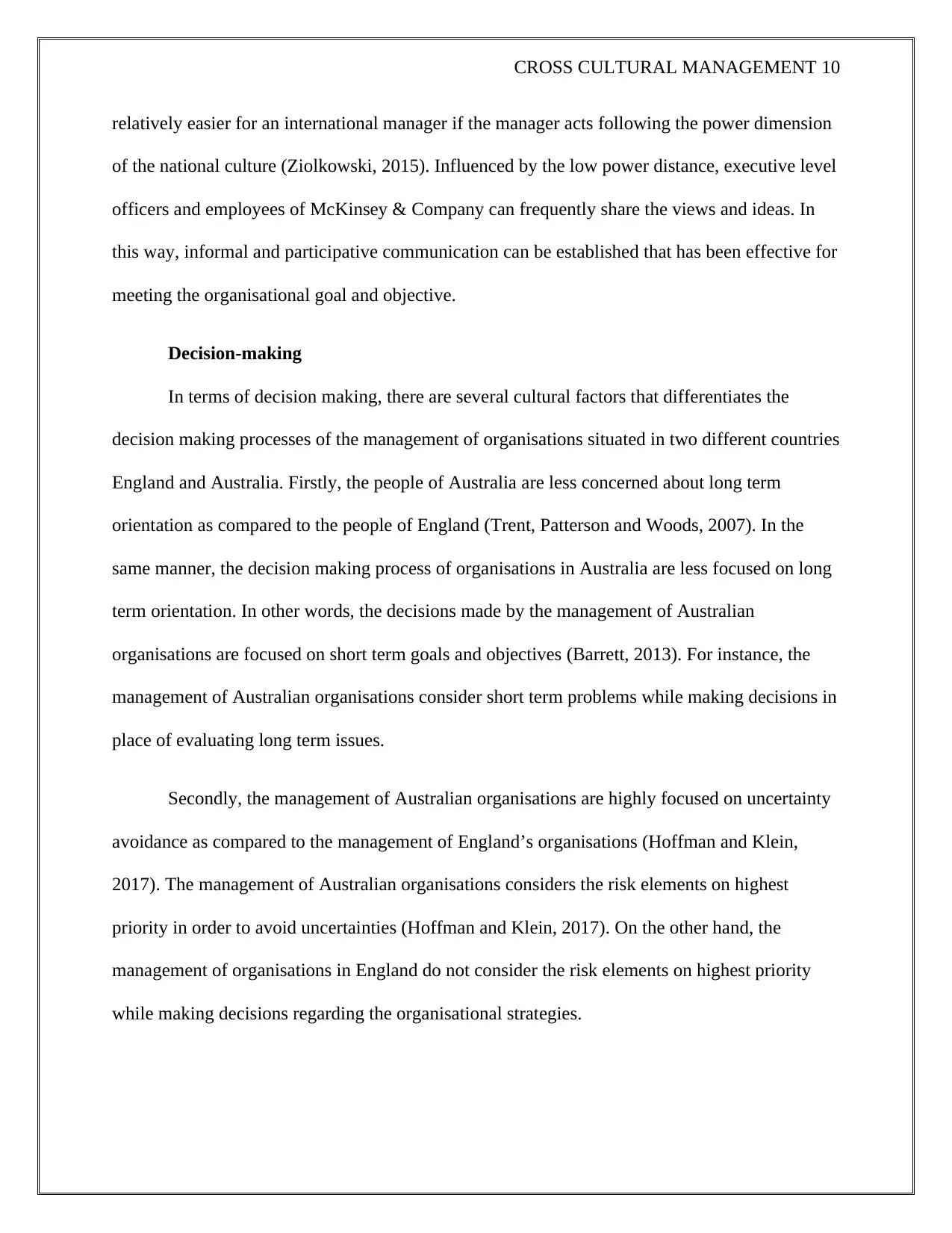
CROSS CULTURAL MANAGEMENT 10
relatively easier for an international manager if the manager acts following the power dimension
of the national culture (Ziolkowski, 2015). Influenced by the low power distance, executive level
officers and employees of McKinsey & Company can frequently share the views and ideas. In
this way, informal and participative communication can be established that has been effective for
meeting the organisational goal and objective.
Decision-making
In terms of decision making, there are several cultural factors that differentiates the
decision making processes of the management of organisations situated in two different countries
England and Australia. Firstly, the people of Australia are less concerned about long term
orientation as compared to the people of England (Trent, Patterson and Woods, 2007). In the
same manner, the decision making process of organisations in Australia are less focused on long
term orientation. In other words, the decisions made by the management of Australian
organisations are focused on short term goals and objectives (Barrett, 2013). For instance, the
management of Australian organisations consider short term problems while making decisions in
place of evaluating long term issues.
Secondly, the management of Australian organisations are highly focused on uncertainty
avoidance as compared to the management of England’s organisations (Hoffman and Klein,
2017). The management of Australian organisations considers the risk elements on highest
priority in order to avoid uncertainties (Hoffman and Klein, 2017). On the other hand, the
management of organisations in England do not consider the risk elements on highest priority
while making decisions regarding the organisational strategies.
relatively easier for an international manager if the manager acts following the power dimension
of the national culture (Ziolkowski, 2015). Influenced by the low power distance, executive level
officers and employees of McKinsey & Company can frequently share the views and ideas. In
this way, informal and participative communication can be established that has been effective for
meeting the organisational goal and objective.
Decision-making
In terms of decision making, there are several cultural factors that differentiates the
decision making processes of the management of organisations situated in two different countries
England and Australia. Firstly, the people of Australia are less concerned about long term
orientation as compared to the people of England (Trent, Patterson and Woods, 2007). In the
same manner, the decision making process of organisations in Australia are less focused on long
term orientation. In other words, the decisions made by the management of Australian
organisations are focused on short term goals and objectives (Barrett, 2013). For instance, the
management of Australian organisations consider short term problems while making decisions in
place of evaluating long term issues.
Secondly, the management of Australian organisations are highly focused on uncertainty
avoidance as compared to the management of England’s organisations (Hoffman and Klein,
2017). The management of Australian organisations considers the risk elements on highest
priority in order to avoid uncertainties (Hoffman and Klein, 2017). On the other hand, the
management of organisations in England do not consider the risk elements on highest priority
while making decisions regarding the organisational strategies.
Paraphrase This Document
Need a fresh take? Get an instant paraphrase of this document with our AI Paraphraser
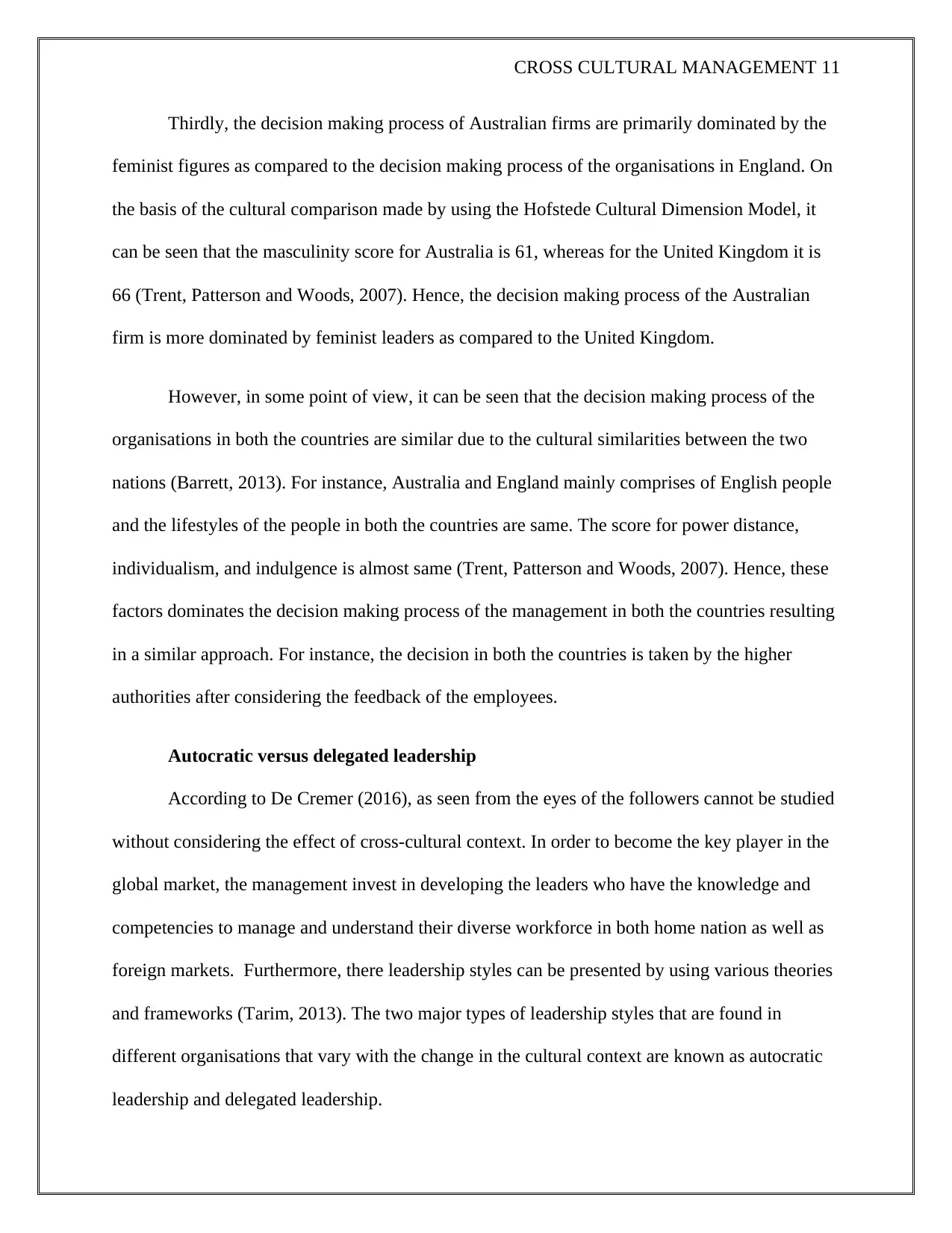
CROSS CULTURAL MANAGEMENT 11
Thirdly, the decision making process of Australian firms are primarily dominated by the
feminist figures as compared to the decision making process of the organisations in England. On
the basis of the cultural comparison made by using the Hofstede Cultural Dimension Model, it
can be seen that the masculinity score for Australia is 61, whereas for the United Kingdom it is
66 (Trent, Patterson and Woods, 2007). Hence, the decision making process of the Australian
firm is more dominated by feminist leaders as compared to the United Kingdom.
However, in some point of view, it can be seen that the decision making process of the
organisations in both the countries are similar due to the cultural similarities between the two
nations (Barrett, 2013). For instance, Australia and England mainly comprises of English people
and the lifestyles of the people in both the countries are same. The score for power distance,
individualism, and indulgence is almost same (Trent, Patterson and Woods, 2007). Hence, these
factors dominates the decision making process of the management in both the countries resulting
in a similar approach. For instance, the decision in both the countries is taken by the higher
authorities after considering the feedback of the employees.
Autocratic versus delegated leadership
According to De Cremer (2016), as seen from the eyes of the followers cannot be studied
without considering the effect of cross-cultural context. In order to become the key player in the
global market, the management invest in developing the leaders who have the knowledge and
competencies to manage and understand their diverse workforce in both home nation as well as
foreign markets. Furthermore, there leadership styles can be presented by using various theories
and frameworks (Tarim, 2013). The two major types of leadership styles that are found in
different organisations that vary with the change in the cultural context are known as autocratic
leadership and delegated leadership.
Thirdly, the decision making process of Australian firms are primarily dominated by the
feminist figures as compared to the decision making process of the organisations in England. On
the basis of the cultural comparison made by using the Hofstede Cultural Dimension Model, it
can be seen that the masculinity score for Australia is 61, whereas for the United Kingdom it is
66 (Trent, Patterson and Woods, 2007). Hence, the decision making process of the Australian
firm is more dominated by feminist leaders as compared to the United Kingdom.
However, in some point of view, it can be seen that the decision making process of the
organisations in both the countries are similar due to the cultural similarities between the two
nations (Barrett, 2013). For instance, Australia and England mainly comprises of English people
and the lifestyles of the people in both the countries are same. The score for power distance,
individualism, and indulgence is almost same (Trent, Patterson and Woods, 2007). Hence, these
factors dominates the decision making process of the management in both the countries resulting
in a similar approach. For instance, the decision in both the countries is taken by the higher
authorities after considering the feedback of the employees.
Autocratic versus delegated leadership
According to De Cremer (2016), as seen from the eyes of the followers cannot be studied
without considering the effect of cross-cultural context. In order to become the key player in the
global market, the management invest in developing the leaders who have the knowledge and
competencies to manage and understand their diverse workforce in both home nation as well as
foreign markets. Furthermore, there leadership styles can be presented by using various theories
and frameworks (Tarim, 2013). The two major types of leadership styles that are found in
different organisations that vary with the change in the cultural context are known as autocratic
leadership and delegated leadership.
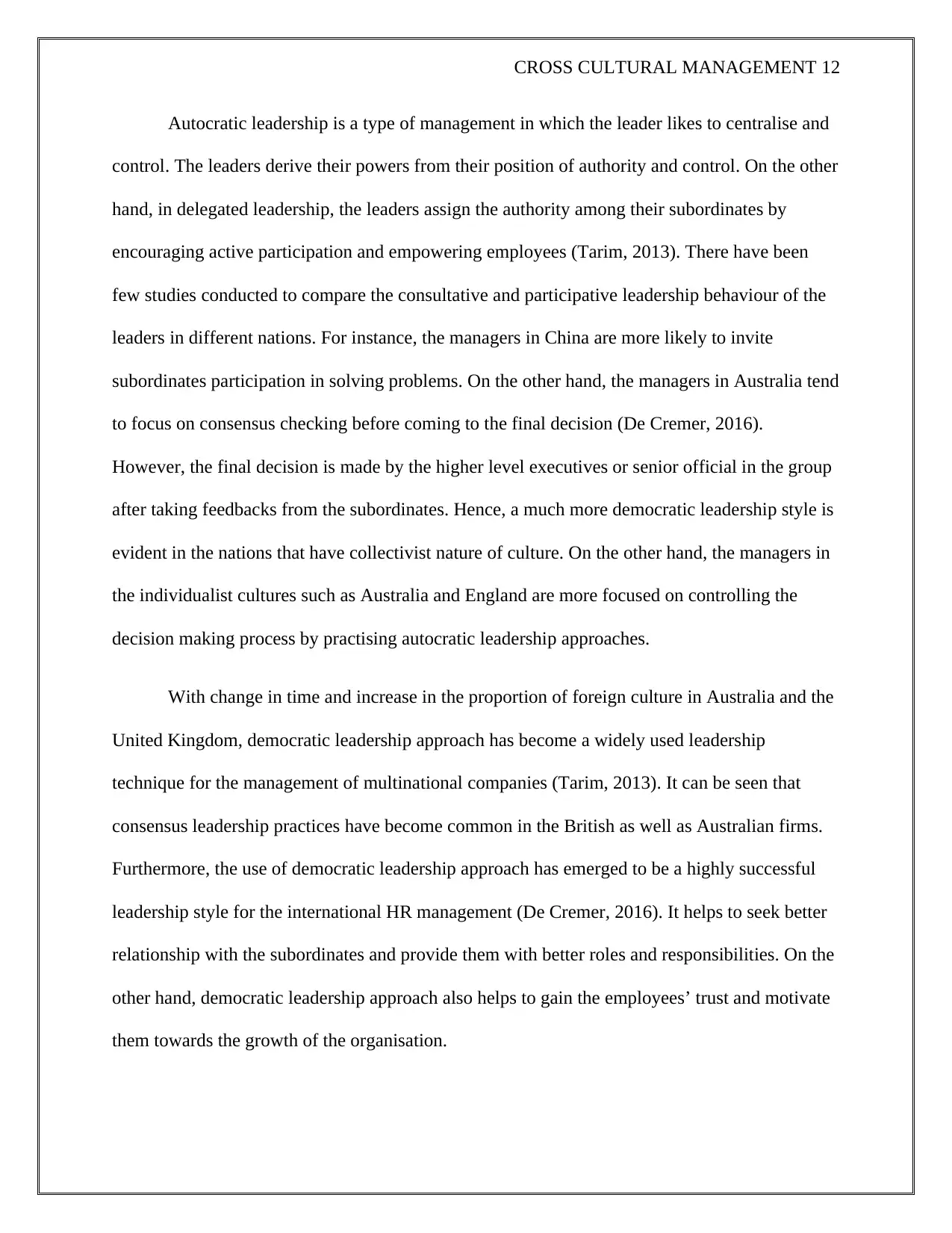
CROSS CULTURAL MANAGEMENT 12
Autocratic leadership is a type of management in which the leader likes to centralise and
control. The leaders derive their powers from their position of authority and control. On the other
hand, in delegated leadership, the leaders assign the authority among their subordinates by
encouraging active participation and empowering employees (Tarim, 2013). There have been
few studies conducted to compare the consultative and participative leadership behaviour of the
leaders in different nations. For instance, the managers in China are more likely to invite
subordinates participation in solving problems. On the other hand, the managers in Australia tend
to focus on consensus checking before coming to the final decision (De Cremer, 2016).
However, the final decision is made by the higher level executives or senior official in the group
after taking feedbacks from the subordinates. Hence, a much more democratic leadership style is
evident in the nations that have collectivist nature of culture. On the other hand, the managers in
the individualist cultures such as Australia and England are more focused on controlling the
decision making process by practising autocratic leadership approaches.
With change in time and increase in the proportion of foreign culture in Australia and the
United Kingdom, democratic leadership approach has become a widely used leadership
technique for the management of multinational companies (Tarim, 2013). It can be seen that
consensus leadership practices have become common in the British as well as Australian firms.
Furthermore, the use of democratic leadership approach has emerged to be a highly successful
leadership style for the international HR management (De Cremer, 2016). It helps to seek better
relationship with the subordinates and provide them with better roles and responsibilities. On the
other hand, democratic leadership approach also helps to gain the employees’ trust and motivate
them towards the growth of the organisation.
Autocratic leadership is a type of management in which the leader likes to centralise and
control. The leaders derive their powers from their position of authority and control. On the other
hand, in delegated leadership, the leaders assign the authority among their subordinates by
encouraging active participation and empowering employees (Tarim, 2013). There have been
few studies conducted to compare the consultative and participative leadership behaviour of the
leaders in different nations. For instance, the managers in China are more likely to invite
subordinates participation in solving problems. On the other hand, the managers in Australia tend
to focus on consensus checking before coming to the final decision (De Cremer, 2016).
However, the final decision is made by the higher level executives or senior official in the group
after taking feedbacks from the subordinates. Hence, a much more democratic leadership style is
evident in the nations that have collectivist nature of culture. On the other hand, the managers in
the individualist cultures such as Australia and England are more focused on controlling the
decision making process by practising autocratic leadership approaches.
With change in time and increase in the proportion of foreign culture in Australia and the
United Kingdom, democratic leadership approach has become a widely used leadership
technique for the management of multinational companies (Tarim, 2013). It can be seen that
consensus leadership practices have become common in the British as well as Australian firms.
Furthermore, the use of democratic leadership approach has emerged to be a highly successful
leadership style for the international HR management (De Cremer, 2016). It helps to seek better
relationship with the subordinates and provide them with better roles and responsibilities. On the
other hand, democratic leadership approach also helps to gain the employees’ trust and motivate
them towards the growth of the organisation.
⊘ This is a preview!⊘
Do you want full access?
Subscribe today to unlock all pages.

Trusted by 1+ million students worldwide
1 out of 19
Related Documents
Your All-in-One AI-Powered Toolkit for Academic Success.
+13062052269
info@desklib.com
Available 24*7 on WhatsApp / Email
![[object Object]](/_next/static/media/star-bottom.7253800d.svg)
Unlock your academic potential
Copyright © 2020–2025 A2Z Services. All Rights Reserved. Developed and managed by ZUCOL.




